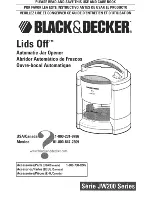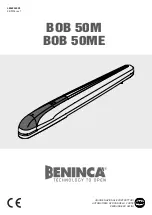
iv
MM271 Installation Instructions
MM271 Installation Instructions
v
I. Before Installation
1.
Verify this operator is proper for the type and size of gate, frequency
of use and class of the gate system.
2.
Make sure the gate has been properly installed and swings freely
in both directions. Repair or replace all worn or damaged gate
hardware prior to installation. A freely moving gate will require less
force to operate and will enhance the performance of the entrapment
protection devices used with the system (see page xii).
3.
Review the operation of the system to become familiar with its
safety features. Understand how to disconnect the operator for
manual gate operation (see page iii).
4.
The gate and operator installation must comply with any applicable
local codes.
5.
This gate operator is intended for vehicular gates only. A separate
entrance or gate must be installed for pedestrian use (see page viii).
6.
Always keep people and objects away from the gate and its area of
travel. No one should cross the path of a moving gate.
7.
Identify all of the entrapment zones for the type of installation. An
entrapment zone is an area around the automatic gate system where
a person or object could be caught that increase the risk of injury.
Entrapment zones must be eliminated, guarded or protected.
8.
When designing a system that will be entered from a highway or
main thoroughfare, make sure the gate system is placed far enough
from the road to prevent traffic congestion.
FOR THE INSTALLER AND END USER
II. During Installation
1. Install the gate operator on the inside of the
property and fence line.
DO NOT
install an
operator on the outside of the gate where the
public has access to it.
2. Be careful with moving parts and avoid close
proximity to areas where fingers or hands could
be pinched.
3. Devices such as contact sensors (sensing
edges) and non contact sensors (photo beams)
provide additional protection against vehicular
damage.
4. If push buttons or key switches are installed,
they should be within sight of the gate, located
at least 10 feet from any moving part of the gate
(see diagram below).
Never install any control
device where a user will be tempted to reach
through the gate to activate the gate operator.
5. Do not activate your gate operator unless
you can see it and can determine that its area
of travel is clear of people, pets, or other
obstructions. Watch the gate through its entire
movement.
6. Secure outdoor or easily accessed gate operator
controls in order to prohibit unauthorized use of
the gate.
FOR THE INSTALLER AND END USER
Typical Entrapment Zones are shown in the diagrams on page iv:
Zone 1
– leading edge of the gate and the fence post.
Zone 2
– between the gate and the gate post.
Zone 3
– the path of the gate.
Zone 4
– the space between the gate in the open position and any object such as a wall, fence, tree, etc.
Zone 5
– pinch points between the operator and gate.
Moving Gate
Area
Driveway
10'
10'
10'
10'
NEVER install any control device
within gray area
Pull-To-Open
Application
Gate in the
Open Position
ZONE 2
ZONE 3
ZONE 4
ZONE 5
Driveway
ZONE 1
Entrapment
Zones for a
Pull-To-Open
Application
1. READ AND FOLLOW ALL INSTRUCTIONS
.
2.
Never let children operate or play with gate controls. Keep the remote
control away from children.
3.
Always keep people and objects away from the gate.
NO ONE
SHOULD CROSS THE PATH OF THE MOVING GATE.
4.
Test the gate operator monthly. The gate MUST reverse on contact with
a rigid object or stop when an object activates the non-contact sensors.
After adjusting the force or the limit of travel, retest the gate operator.
Failure to adjust and retest the gate operator properly can increase the
risk of injury or death.
5.
Use the manual/emergency release only when the gate is not moving.
6. KEEP GATES PROPERLY MAINTAINED
. Read the
user’s manual. Have a qualified service person make repairs to
gate hardware.
7.
The entrance is for vehicles only. Pedestrians must use sepa-
rate entrance.
8.
The gate must be installed in a location that provides adequate
clearance between it and adjacent structures when opening and
closing to reduce the risk of entrapment. Swinging gates must
not open into public access areas.
9. SAVE THESE INSTRUCTIONS
.
To reduce the risk of injury or death:
WARNING
Important Safety Information
Important Safety Information





































